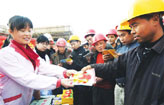Society
Can nuclear power plants float?
Updated: 2011-04-18 17:35
(Agencies)
MOSCOW - A tsunami-crippled nuclear power plant might give some countries pause over the risks of exposing reactors to the power of the oceans. Not Russia.
"We are not worried. Even Japan has no alternative to atomic energy. The safety on Russian reactors is many times higher," said Andrey Fomichev, head of St. Petersburg's Baltiysky shipyard, which is building the 144 metre-long (472 ft) barge that will be towed into place in an as yet undisclosed location next year.
The seaborne plant is at the heart of Russia's strategy to exploit the Arctic's vast energy resources in the coming decades - an expansion into one of the world's last true wildernesses. Consisting of two small reactors that will generate 70-megawatts of electricity, enough to light up more than 35,000 homes, the plant will sit at dock or anchor close to shore so that it can hook up to cables to transmit electricity.
The floating reactor, named the Akademik Lomonosov after the renowned 18th-century Russian scientist and poet Mikhail Lomonosov, is based on "tried-and-true" Cold War submarine and atomic icebreaker technology, Fomichev told Reuters by telephone. "All possible emergency situations have been tested. Safety testing began under the Soviet Union."
But nuclear-energy skeptics warn that Russia's plans, which call for construction of at least seven more such reactors, could be the most dangerous in the atomic energy sector in years - not only because of the risk of an accident but because they could fuel proliferation and terrorism.
"You can't promise an inherently safe nuclear reactor... and by floating these things and towing them off to remote locations you multiply the risks," said Paris-based independent nuclear-energy consultant Mycle Schneider. "It's entirely ridiculous."
Small Is Beautiful - or Maybe Not
Russia is not the only country to move toward shrinking its reactors, but it is pushing the idea more vocally than others, touting projects from nuclear-powered spacecraft to reactors small enough to fit in a backyard.
The International Atomic Energy Agency (IAEA) predicts that at least 40 and as many as 90 such mini reactors will be in operation worldwide by 2030.
Fomichev said small plants can be built to power remote areas in the developing world, power-hungry industrial projects, or military bases, without the need for expensive energy grids. "Such facilities can be built for the far north, the desert," he said. "It's a quick fix for hard-to-reach regions. Deploy it and you can build factories, army bases, oil rigs. You have electricity, water and heat."
Russia's state nuclear-energy giant Rosatom has plans to build 12 floating plants, which it hopes to sell for export. One of the pilot barge's most-touted selling points, energy-intensive seawater desalination, is clearly aimed to appeal to Middle Eastern and African nations. Rosatom said more than 20 countries have voiced interest in the project, including China, South Korea, Indonesia, The Philippines, Namibia, Chile and Brazil.
The first reactor will likely end up costing $550 million to build, more than four times the initial estimate but still a fraction of the price of a traditional, large-scale reactor.
Oleg Chernikov, the deputy director of the operating company, Rosenergoatom, argues that the floating plants will be earthquake-proof by the sheer fact it will be moored out at sea.
But antinuclear activists warn that if a floating plant is deployed in the tsunami-prone, volcanically active seas off Russia's far-eastern Kamchatka region - as reports have suggested the first plant might be - a nuclear accident would be "unavoidable".
"The danger is not an earthquake itself, but the tsunami it generates. If a working floating nuclear reactor were dashed against the shore in a tsunami, it would mean an unavoidable nuclear accident," said Alexander Nikitin, a former Soviet submarine naval captain and atomic safety inspector turned antinuclear campaigner.
One industry source familiar with the plans said the plant was not bound for a seismically active location. "There are rumors... but the contract names a different location," said the source, who asked to remain anonymous because he was not authorised to speak to the media.
Terrorism, Spent Fuel
But one of the men who first authorised the project now doubts the logic behind it. Bulat Nigmatulin, Russia's deputy minister for atomic energy between 1998 and 2002, said floating plants have no potential market and are a waste of state funds. "Nobody needs this. We're funding this useless thing ourselves, out of the state coffers," Nigmatulin told Reuters.
Setting reactors afloat anywhere in the Pacific, where they risk being capsized by tsunamis, is "simply crazy," he said, dismissing with a sweep of his hand a map of possible interested client nations around the globe. "Everywhere else is full of pirates and terrorists."
Nigmatulin believes the project highlights the worst of Russian industry: massive subsidies, unprofitable projects and a lack of transparency that leads to delays and corruption.
Moscow's ambitious plans have also fuelled concerns over terrorism and what do to with highly radioactive spent nuclear fuel. Antinuclear activists say Rosatom's list of potential clients raises concerns over nuclear proliferation. "They are all countries who want to gain access to nuclear submarine technology," Greenpeace energy expert Vladimir Chuprov said.
"While Fukushima may not spell the funeral of atomic energy, it has shown up the industry's unsolved safety problems, including the threat of terrorism," adds Konstantin Simonov, director of the Moscow-based National Energy Security Foundation.
Far from being innovative, environmentalists said Russia is dusting off risky, outdated designs in its drive to capitalise on the recent boom in global demand for nuclear energy. The technology used in the floating plants caused at least 10 accidents aboard Soviet submarines between the 1970s until the early 1990s, according to the Oslo-based antinuclear group Bellona.
"Any history of nuclear submarines is a history of accidents," Bellona campaigner Nikitin said.
Russia says it will deal with the nuclear waste produced by any plant it sells. But Nikitin said no solution has yet been found to process the spent fuel, which is highly radioactive. In traditional reactors, the spent fuel is removed and stored in pools -- like those under threat at Japan's Fukushima plant. But in the marine reactor models Russia is promoting, the fuel is frozen and stored along with the reactor cores.
Hundreds of those spent fuel rods still litter the Russian Arctic today.
"The phobia over atomic energy is not going to fade fast. Who will want these things now?" Simonov asked.
E-paper

Han me downs
Traditional 3,000-year-old clothes are making a comeback.
Reaching out
Fast growth fuels rise in super rich
Chinese tourists spend more
Specials

Big spenders
More mainland tourists are expected to spend money on overseas travel this year.

Rise in super rich
Report cites rising property prices, gdp as key drivers of increasing number of chinese millionaires.

Reaching out
Condom makers are stepping up their presence in smaller cities to boost sales




